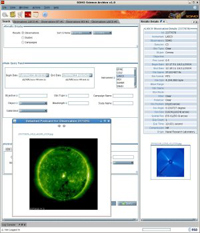ESA's new SOHO science archive now online
23 November 2009
Access to data from the ESA-NASA SOHO mission has just become easier with the launch of a new SOHO science archive with enhanced capabilities for searching and visualising the vast SOHO data archive. This is the first in a new generation of science archives under development at ESA's European Space Astronomy Centre.Since operations began in 1995 the Solar and Heliospheric Observatory (SOHO) has been transmitting data from its twelve scientific instruments back to Earth at a rate of 1 Gigabyte per day. Analysis of this data has resulted in ground-breaking scientific results which have included the first images of a star's convection zone and the structure of sunspots below the photosphere; the most precise measurements of the temperature structure, interior rotation, and gas flow in the solar interior; the discovery of new dynamic phenomena such as coronal waves and solar tornadoes, and the discovery of more than 1600 comets.
 |
| Screenshot of the SOHO science archive interface. Credit: ESA |
The recently launched ESA SOHO Science Archive allows for seamless access to the complete archive of science data sets from the 12 instruments as soon as the data are processed. A Graphical User Interface, based on state-of-the-art technology, provides both the expert and layman with access to a wide variety of data including helioseismic measurements of the centre of the Sun, full-disc images of the solar atmosphere in different wavelengths, and measurements of the solar wind filling the interplanetary media. The ability to generate on-the-fly sequences of images facilitates viewing in minutes processes that take days or months in real time. This type of tool has contributed to discoveries of new solar phenomena, such as the aforementioned coronal waves, solar tornadoes, and even new comets.
Innovation and interoperability are key to the new archive
One of the challenges in developing the new archive was to find a way to provide a quick response to queries of a complex database of more than 2 million solar observations. The complex relations between the data fields resulted in slow responses when using traditional database searches. This was overcome by applying the Dijkstra graph theory search algorithm to database searches. By generating table joins "on-the-fly", database searches are improved resulting in better response times when compared to the traditional approach. A simple query of all observations within the SOHO science archive, for instance, takes less than a second to return results, a response that could not be achieved using the traditional methods.
|
Video sequences of the Sun can be created on-the-fly with the new science archive. The examples here depict comets passing through the LASCO fields of view (above, left and right), and a giant X-ray flare seen by the EIT instrument (left). Credit: ESA |
Enhanced functionality in the archive is provided by the 'Time Animator', a platform-independent tool that instantly generates video sequences of the Sun. Several imaging instruments can be selected at one time to create parallel video sequences.
The new archive has been developed in compliance with protocols defined by the International Virtual Observatory Alliance (IVOA). In addition, scientific requirements from the community have been gathered by the Archive Scientists and converted into functionalities within the archives. These two factors along with the ability to interface with standard analysis tools that are also VO compliant renders this archive an essential tool in solar research.
Preserving the legacy of the ESA science missions
The SOHO science archive is the first in a series of new generation scientific archives being developed and implemented by the Science Archives and Virtual Observatory Team at the European Space Astronomy Centre in Spain. These archives will contribute to preserving the legacy of ESA's science missions by conserving and providing access to data from all of these missions.
Contacts
For further details about the ESA SOHO Science Archive please contact:
Pedro Osuna, Science Archives and VO Team Leader
Email: Pedro.Osuna esa.int
esa.int
Luis Sánchez, SOHO Archive Scientist
Email: Luis.Sanchez esa.int
esa.int
Christophe Arviset, Head of the Science Archives and Computer Support Engineering Unit
Email: Christophe.Arviset esa.int
esa.int
Bernhard Fleck, ESA SOHO Project Scientist
Email: Berhard.Fleck esa.int
esa.int



